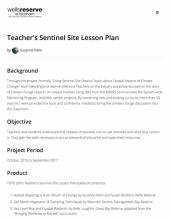
Using Sentinel Site Data to Teach about Coastal Impacts of Climate Change
The National Estuarine Research Reserve System has a proven track record of successfully transferring and translating reserve science to a broad suite of educators through teacher workshops. In recent years, teachers have expressed a need for curriculum, data sets, and professional development related to climate change. A 2015 Science Transfer grant enabled the Northeast reserves (Great Bay, Narragansett Bay, Waquoit Bay, Wells) to develop and offer a series of high-quality teacher workshops focused on the story of climate change impacts on coastal habitats, using a variety of data collected at the reserves.
The project team developed this Teachers on the Estuary (TOTE) teaching module, which focuses on communicating the concept of blue carbon and the impacts of sea level rise on salt marshes to teachers and students.
The lesson plan booklet contains materials for four activities:
- Habitat Mapping: A River Mouth of Change by Suzanne Kahn and Susan Bickford, Wells Reserve
- Salt Marsh Vegetation & Sampling Techniques by Maureen Dewire, Narragansett Bay Reserve
- Sea Level Rise and Coastal Wetlands by Kelle Loughlin, Great Bay Reserve (adapted from the "Bringing Wetlands to Market" curriculum)
- Student Sentinel Sites at Schools by Joan Muller, Waquoit Bay Reserve
The curriculum can also be accessed through the Wells Reserve and through the NERRS Estuary Education Curriculum page.